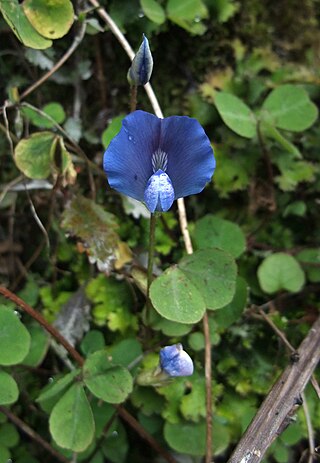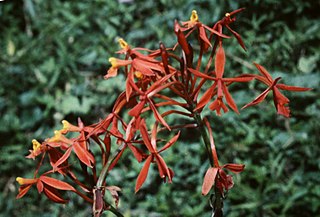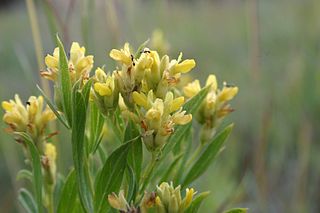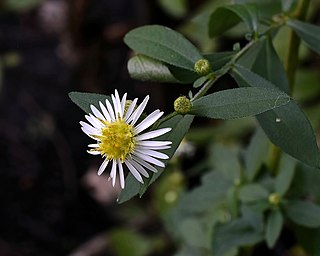
Adonis is a genus of about 20–30 species of flowering plants of the crowfoot family, Ranunculaceae, native to Europe and Asia.

The plant tribe Phaseoleae is one of the subdivisions of the legume subfamily Faboideae, in the unranked NPAAA clade. This group includes many of the beans cultivated for human and animal food, most importantly from the genera Glycine, Phaseolus, and Vigna.

Cinchona officinalis is a South American tree in the family Rubiaceae. It is native to wet montane forests in Colombia, Ecuador, Peru and Bolivia, between 1600–2700 meters above sea level.

Astragalus lemmonii, the Lemmon's milkvetch, is a rare plant of eastern California. It is a member of the bean family, the Leguminosae, and specifically a member of the subfamily Papilionoideae. The genus Astragalus is a large genus within this family; members of this genus are known as milkvetches or locoweeds. Close relatives of this particular species include Astragalus peckii and Astragalus lentiformis.

Parochetus communis, known in English as shamrock pea or blue oxalis, is a species of legume, and the only species in the genus Parochetus and in the subtribe Parochetinae. It is a low-growing plant with blue papilionaceous flowers and clover-like leaves. It is found in the mountains of Asia and tropical Africa, and has been introduced to New Zealand.

Epidendrum macrocarpum, widely known as Epidendrum schomburgkii, is a species of orchid in the genus Epidendrum, and the largest-flowering crucifix orchid species. Reichenbach thought that E. fulgens and E. schomburgkii var. confluens were both synonyms for this species.
Clitoriopsis is a genus of flowering plants in the legume family, Fabaceae. It belongs to the subfamily Faboideae. The genus contains a single species, Clitoriopsis mollis, a subshrub native to South Sudan and Democratic Republic of the Congo. It grows in seasonally-dry tropical forest margins, woodland, and wooded grassland.
Bulbophyllum xanthornis is a species of orchid in the genus Bulbophyllum.

Monanthes anagensis is the largest species in the genus Monanthes, forming little bushes about 15 centimetres (5.9 in) high. Leaves are laxly spaced, linear-elliptic, quite smooth, and 1.5–2 centimetres (0.6–0.8 in) long. When stunted, it somewhat resembles Monanthes laxiflora but differs from any form of that variable species in its distinctly shrubby habit, alternate longer and narrower leaves which are green, red, or purplish, never grey, and ovoid buds, the buds of M. laxiflora being broader than long.

Centrosema virginianum is known by the common names of spurred butterfly pea, wild blue vine, blue bell, and wild pea. C. virginianum is a member of the family Fabaceae, it is identified by its trailing and twining vine and showy flowers. C. virginianum habitats are in sunny areas within pine lands, and coastal uplands.

Coprosma acutifolia, is a shrub that is native to New Zealand, found only on Raoul Island. C. acutifolia can grow up to 12 metres tall in wet or dry forest, becoming a sub-canopy tree at lower altitudes and a canopy species along ridgelines.
Syringa pinetorum is a species in the genus Syringa, in the family Oleaceae.

Pearsonia cajanifolia is a South African shrublet belonging to the family of Fabaceae, and one of 13 species in the genus, usually herbs or shrublets with woody rootstocks and all occurring in Africa south of the equator with the exception of 1 species found on Madagascar. P. cajanifolia is commonly found in submontane grassland, at altitudes 1350–2100 m, in the South African provinces of Free State, Gauteng, Limpopo, Mpumalanga, and North West, also in Zimbabwe and Malawi.

The tribe Diocleae is one of the subdivisions of the plant family Fabaceae.

Vigna parkeri, the creeping vigna or vigna menjalar, is a climbing or prostrate perennial vine that grows in subtropical areas such as Kenya, Indonesia, and Madagascar.

Symphyotrichum ontarionis is a species of flowering plant in the family Asteraceae native to eastern North America. Commonly known as Ontario aster and bottomland aster, it is a perennial, herbaceous plant that may reach heights of 120 centimeters. Each flower head has many tiny florets put together into what appear as one.

Otholobium saxosum is a small shrublet of up to 20 cm (7.9 in) high that has been assigned to the Pea family, with branches upright or horizontal at the base with rising tips. It has sessile, clover-like leaves and white, pea-like flowers that grow in triplets in the axils of the upper leaves of new, short side shoots. The species is only known from Garcia's Pass in Western Cape province of South Africa. Flowering occurs in October and November.

Dianthus thunbergii is a species of flowering plant in the family Caryophyllaceae.

Flemingia grahamiana is a species of flowering plant in the family Fabaceae. Extracts of the plant are used in the dyeing of silk and cotton in parts of India, Africa, and the Middle East.

Ourisia muscosa is a species of flowering plant in the family Plantaginaceae that is endemic to páramo habitats in the Tropical Andes mountains of Colombia, Ecuador, Peru, Bolivia and Chile. George Bentham described O. muscosa in 1846. Plants of this species of South American foxglove are small, perennial, and repent herbs with entire and tightly clustered, sometimes opposite, leaves. The flowers are solitary, with a regular calyx, and a regular corolla, and with two floral bracts that cover the calyx. The calyx has tiny glandular hairs, whereas the corolla is glabrous and white on the outside, and yellow and hairy inside.

















